The German people, like us, must make the attempt to shut these companies down. We don't need them anyway, I have found out. They literally kill more citizens in one year than guns, or automobiles and yet nothing is said or done about the millions a year these legal drugs and other poisons kill, without a thought.
Contributors Note: Among its many crimes against the human race, Bayer was caught "red handed" dumping AIDS laced medication in Europe and Asia. http://socioecohistory.wordpress.com/2009/03/09/bayer-exposed-hiv-contaminated-vaccine/
Both times this company claimed it was an accident. Now they are positively implicated in the poisoning of millions of honey bees all over the world. Motive? No bees, no pollination, no food, and thus no humans. Is it too much to conclude that this malevolent behavior of this corporate deathstar is "enemy action?" Will people ever wake up?
And no, it is not Bayer that is the problem!!! Bayer is just a corporate front. You have to look behind the curtain. WHO is it that owns and controls Bayer, Monsanto, Merck etc., and the industrial food/pharmaceutical complex? (VN: See VN below about who is on the Board of directors and their background and relationships and you will see its the same ones that own the Military Industrial complex, the banks, the Food companies and the MSM 96% ownership. Yup, the international bankers are going to own everything and contract out when globalized to the gov and then the Tax payer picks up the losses and does not share in the profits, and has no control over actions like this one. Damn this makes me mad.)
Protect yourself!!! (VN: When ever someone keeps telling you for a year, we are going to have riots over food shortages, and civil war because of it, then you know they did the deed that would create just such a condition. Remember the dialectic..... "chaos, reaction, solution"... and that is exactly what this is all about, along with depopulation, they never do something for just one reason, there are always multiple reasons and that is one of them. Board chairman of Bayer, a German Company, is Oxford trained.... that screams volumes. Its the training ground for the illums offspring. This is where their satanic training is completed.)
http://beforeitsnews.com/agriculture/2012/08/the-missing-bees-now-that-we-know-who-did-it-will-bayer-replace-them-2444052.html
Now That We Know Who Killed the Honey Bees, Will They Replace Them?
August 7, 2012 |By admin , Contributed to Vatic Project by Lifeforce from Montana
By Dan Eden
The Missing Bees: Now that we know who did it… Will BAYER Replace Them?
Honey bees are dying all over the globe. Here’s why!
Since 2007, the media has been reporting about the dramatic loss of bees in Europe and North America. As many as 50% to 90% of the bee populations have simply vanished, leaving their hives empty and forcing farmers to demand investigations to determine the cause.
At first it was only the honeybees that were decimated — then the bumblebee populations began to disappear. Bumblebees are responsible for pollinating an estimated 15 percent of all the crops grown in the U.S., worth $3 billion, particularly those raised in greenhouses. Those include tomatoes, peppers and strawberries. The crisis was eventually given a name: Colony Collapse Disorder or CCD.
CCD is a “fake disease!”
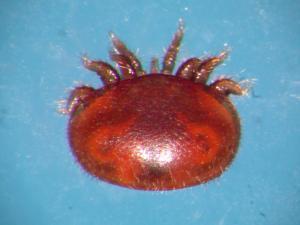 The most popular theory, aside from the varroa mite [right] and cellphone RF radiation, has been the belief that a virus — similar to AIDS — has infected the bees.
The most popular theory, aside from the varroa mite [right] and cellphone RF radiation, has been the belief that a virus — similar to AIDS — has infected the bees.
A team led by scientists from the Columbia University Mailman School of Public Health, Pennsylvania State University, the USDA Agricultural Research Service, University of Arizona, and 454 Life Sciences found a significant connection between the Israeli Acute Paralysis Virus (IAPV) and colony collapse disorder (CCD) in honey bees.
A team of scientists from Edgewood Chemical Biological Center and University of California San Francisco identified both a virus and a parasite that are likely behind the recent sudden die-off of honey-bee colonies. Using a new technology called the Integrated Virus Detection System (IVDS), which was designed for military use to rapidly screen samples for pathogens, ECBC scientists last week isolated the presence of viral and parasitic pathogens that may be contributing to the honeybee loss.
But it now appears that a much more basic culprit has killed the bees — Bayer Corporation. (VN: Board Chairmen was educated at the global home of secret societies, Oxford and corp headquarters located in Germany, original home of Weishaupt and Rothschilds) Colony Collapse Disorder is poisoning with a known insect neurotoxin called Clothianidin, a pesticide manufactured by Bayer, which has been clearly linked to massive bee die offs in Germany and France.
UPDATE: April 8, 2012
The current issue of Science Daily publishes solid proof that Bayer’s Imidacloprid is the latest culprit. This, after initial findings that their product, Clothianidin, cause widespread bee deaths and was banned in several European countries. Farmers were apparently encouraged to switch to a similar pesticide, Imidacloprid, which as now been found to be even more deadly. Read about HERE
“Lu and his co-authors hypothesized that the uptick in CCD resulted from the presence of imidacloprid, a neonicotinoid introduced in the early 1990s. Bees can be exposed in two ways: through nectar from plants or through high-fructose corn syrup beekeepers use to feed their bees. (Since most U.S.-grown corn has been treated with imidacloprid, it’s also found in corn syrup.)In the summer of 2010, the researchers conducted an in situ study in Worcester County, Mass. aimed at replicating how imidacloprid may have caused the CCD outbreak. Over a 23-week period, they monitored bees in four different bee yards; each yard had four hives treated with different levels of imidacloprid and one control hive. After 12 weeks of imidacloprid dosing, all the bees were alive. But after 23 weeks, 15 out of 16 of the imidacloprid-treated hives — 94% — had died. Those exposed to the highest levels of the pesticide died first.
The characteristics of the dead hives were consistent with CCD, said Lu; the hives were empty except for food stores, some pollen, and young bees, with few dead bees nearby. When other conditions cause hive collapse — such as disease or pests — many dead bees are typically found inside and outside the affected hives.Strikingly, said Lu, it took only low levels of imidacloprid to cause hive collapse — less than what is typically used in crops or in areas where bees forage.”
On January 21, 1986 a patent was filed, and granted on May 3, 1988, for imidacloprid in the United States (U.S. Pat. No. 4,742,060) by Nihon Tokushu Noyaku Seizo K.K. of Tokyo, Japan.[6] On March 25, 1992, Miles, Inc. (later Bayer CropScience) applied for registration of imidacloprid for turfgrass and ornamentals in the United States. On March 10, 1994, the U.S. Environmental Protection Agency approved the registration of imidacloprid. It is one of Bayer’s top agricultural products.
Here’s the situation…
One of the most important crops is corn. It’s used as a feed for chickens and pigs and cattle. It’s used in flour and in the production of high fructose corn syrup. Just about everything we eat depends on corn. Recently, with the energy crisis, corn has also been pressed to make ethanol to run our cars. But corn has an enemy called the root worm.
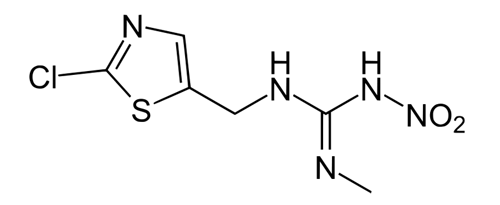
nitroguanidine
Trade named: Poncho 600, Prosper and Elado, a Nitroguanidine subgroup of nicotinoids produced by Bayer Corporation and registered in 2003.
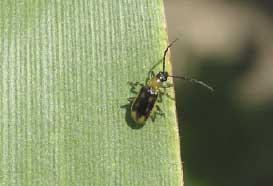
This pesky bug, called diabrotica vergifera vergifera, [right] burrows in the newly forming roots of the corn plant and causes the plant to wither and eventually die. Farmers have long sought some type of pesticide to kill the bug and, in 2003, Bayer Pharmaceutical introduced a new products called Clothianidin and Imidacloprid.
Their own studies showed that these pesticide were highly toxic to bees but justified the widespread use because it could be applied to corn seed and would be buried in the soil where it would presumably be harmless to other creatures.
Their own studies showed that these pesticide were highly toxic to bees but justified the widespread use because it could be applied to corn seed and would be buried in the soil where it would presumably be harmless to other creatures.
In theory, farmers were instructed to buy special machines that would coat their seeds multiple times with clothianidin and a special adhesive, dry the seeds, and then plant them. The poison is supposed to stick to the seed coat and to be toxic to the rootworm as it attempts to burrow in to the newly forming roots.
Bayer, who make the pesticide, and Monsanto, who make the adhesive, have patented the method of coating their proprietary seeds with clothianidin and imidacloprid, which are now growing all over the globe.
Oooooops!
The first clue that Colony Collapse Disorder was a simple case of poisoning — similar to the DDT bird kill-off decades ago — was when clothianidin was used on corn crops in Germany’s Baden-Wuerttemberg state.
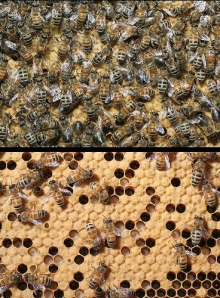 In July of 2007, the German crop was infested with the rootworm. The German government ordered that every possible method should be used to eradicate this pest, including the use of clothianidin (and now Imidacloprid). Shortly after the seeds were planted, in May of 2008, some 330-million bees abruptly died! The global phenomenon of has continued to this day.
In July of 2007, the German crop was infested with the rootworm. The German government ordered that every possible method should be used to eradicate this pest, including the use of clothianidin (and now Imidacloprid). Shortly after the seeds were planted, in May of 2008, some 330-million bees abruptly died! The global phenomenon of has continued to this day.
According to the German Research Center for Cultivated Plants, 29 out of 30 dead bees had been killed, in the 2008 study, by direct contact with clothianidin.
Philipp Mimkes, spokesman for the German-based Coalition Against Bayer Dangers, said: “We have been pointing out the risks of neonicotinoids for almost 10 years now. This proves without a doubt that the chemicals can come into contact with bees and kill them. These pesticides shouldn’t be on the market.”
An investigation revealed that the seed coating did not stay in the soil but was introduced to the air (and the rest of the plant) by simple abrasion — the rubbing together of seeds — as they are stored, moved and injected in to the soil by farming machines.
German authorities suggested that the seeds were not treated with a special polymer, called a “Sticker,” which makes the pesticide adhere to the seed. But it is noted also that the formulation of clothianidin does not require this “sticker” in typical applications and most farmers find this additional coating too cost prohibitive.
The German government quickly banned this pesticide and gave compensation to the farmers and issued a strong warning against using this chemical in agriculture. According to the German Federal Agriculture Institute,
“It can unequivocally be concluded that poisoning of the bees is due to the rub-off of the pesticide ingredient clothianidin from corn seeds.”
According to the U.S. Environmental Protection Agency (May 30, 2003):
“Clothianidin has the potential for toxic chronic exposure to honey bees, as well as other nontarget pollinators, through the translocation of clonianidin redidue in nectar and pollen.”[In the same report] “The fate and disposition of clothianidin in the environment suggest a compound that is asystemic insecticide that is persistent and mobile, stable to hydrolysis, and has potential to leach to ground water, as well as runoff to surface waters.”
“Clothianidin is highly toxic to honey bees on an acute contact basis (killing 50% of tested populations at greater than 389 mg/kg). It has the potential for toxic chronic exposure to honey bees, as well as other nontarget pollinators, through the translocation of clothianidin residues in nectar and pollen. In honey bees, the effects of this toxic chronic exposure may include lethal and/or sub-lethal effects in the larvae and reproductive effects in the queen.”
Clothianidin & Imidacloprid = neurotoxins
The cigarette industry used to brag that one or two cigarettes doesn’t give a person lung cancer. Likewise, the pharmaceutical companies are quick to show that feeding bees a specific amount of neurotoxins, like clothianidin and Imidacloprid, doesn’t kill the bees. And, of course, this is true.
While small traces of clothianidin or imidacloprid may not kill bees outright, it can and apparently does interfere with their ability to navigate to and from the hive. The pollen that they manage to bring back to the hive is then further concentrated and exposed to the entire colony, causing suppression of their immune systems and subsequent infection by any number of parasites and pathogens. This is exactly what beekeepers and farmers have been reporting — half empty, infested bees or abandoned hives with no dead bodies to be found anywhere. It has also been noted that the empty colonies are absent the usual parasitic bugs that typically take advantage of an abandoned hive. The colonies appear sterile.

People dressed as bees demonstrate against pesticides 21 April 2007 in front of the Bayer headquarters in Brussels. Three millions bees have been dying each year since the introduction on the market of the pesticide manufactured by Bayer. Poster reads :’Gaucho Bayer, only kills if one uses it.’
Not Just Corn
The tragedy in Germany and France showed that bees who became exposed to clothianidin also infected bee colonies that were not harvesting corn pollen, thus spreading the toxin to regions at some distace to areas cultivating corn plants. It is theorized that they could have become disoriented and mingled with bees from other colonies or contaminated the pollen of plants where other bee colonies were also pollenating.
Then there is this new evidence that a similar chemical, imidacloprid, also marketed by Bayer, can produce colony collapse at levels far below those used in agriculture! What’s going on here?
Same old story… Will they ever replace the bees?
 Money talks. Agro-business is huge and their influence is deep in the sciences and politics. Their own scientists must know very well that their product has threatened the global population of bees, yet they allow the conspiracy theories of a mysterious “Colony Collapse Disease” to endure. Clothianidin and imidacloprid (another pesrticide also banned by Germany and France) account for much of Bayer’s agrochemical profits.
Money talks. Agro-business is huge and their influence is deep in the sciences and politics. Their own scientists must know very well that their product has threatened the global population of bees, yet they allow the conspiracy theories of a mysterious “Colony Collapse Disease” to endure. Clothianidin and imidacloprid (another pesrticide also banned by Germany and France) account for much of Bayer’s agrochemical profits.
I used to think of Bayer as the company that made aspirin and medicine, but I recently saw a list of poisons that they made and marketed to kill everything from microbes to insects. It seems odd to me that a company that makes poisons also makes medical cures… Is there a link there? Perhaps it’s just different sides of the same dollar or Euro.
We need justice. Bayer developed, manufactured, experimented and lobbied to get these pesticides on the market and they hindered their recall when proof was known about how damaging they were. Years passed as the bees around the globe have died in large numbers. Bayer killed the them. Will Bayer replace all the bees?
UPDATE
(08-18) 18:37 PDT — The U.S. Environmental Protection Agency is refusing to disclose records about a new class of pesticides that could be playing a role in the disappearance of millions of honeybees in the United States, a lawsuit filed Monday charges.
The Natural Resources Defense Council wants to see the studies that the EPA required when it approved a pesticide made by Bayer CropScience five years ago.
The environmental group filed the suit as part of an effort to find out how diligently the EPA is protecting honeybees from dangerous pesticides, said Aaron Colangelo, a lawyer for the group in Washington.
The EPA granted conditional registration for clothianidin in 2003 and at the same time required that Bayer CropScience submit studies on chronic exposure to honeybees, including a complete worker bee lifecycle study as well as an evaluation of exposure and effects to the queen, the group said. The queen, necessary for a colony, lives a few years; the workers live only six weeks, but there is no honey without them.
“The public has no idea whether those studies have been submitted to the EPA or not and, if so, what they show. Maybe they never came in. Maybe they came in, and they show a real problem for bees. Maybe they’re poorly conducted studies that don’t satisfy EPA’s requirement,” Colangelo said.
~~ Help Waking Times to raise the vibration by sharing this article with the buttons below…
The article is reproduced in accordance with Section 107 of title 17 of the Copyright Law of the United States relating to fair-use and is for the purposes of criticism, comment, news reporting, teaching, scholarship, and research.

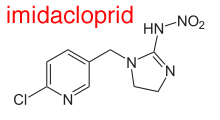
2 comments:
A dog returns to its vomit. Bayer was one of six companies to merge in 1927, forming IG Farben, the maker of the Zyklon-B poison gas used to kill people in concentration camps during World War II. (See: http://en.wikipedia.org/wiki/IG_Farben#Foundation_of_IG_Farben)
It's worth noting that, in IG Farben's German and American branches, central bankers Paul and Max Warburg served on the boards of directors.
Post a Comment